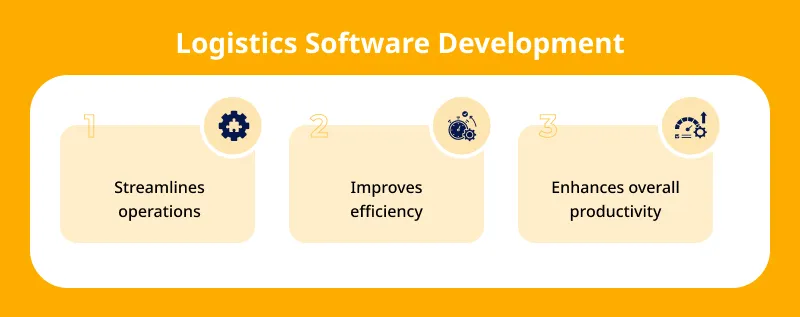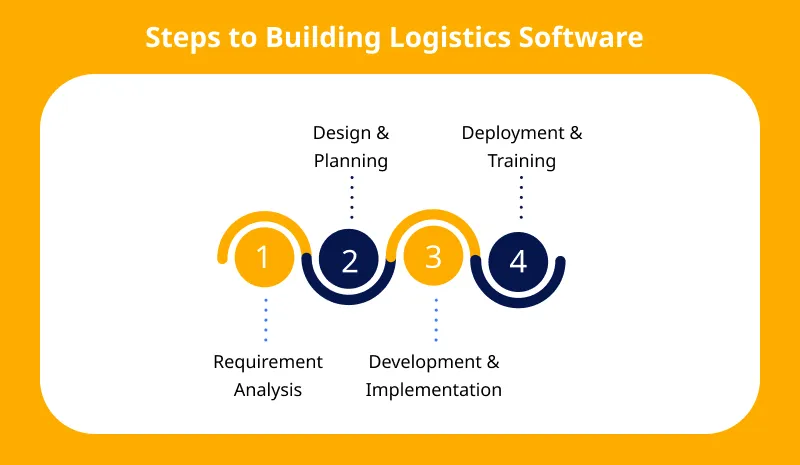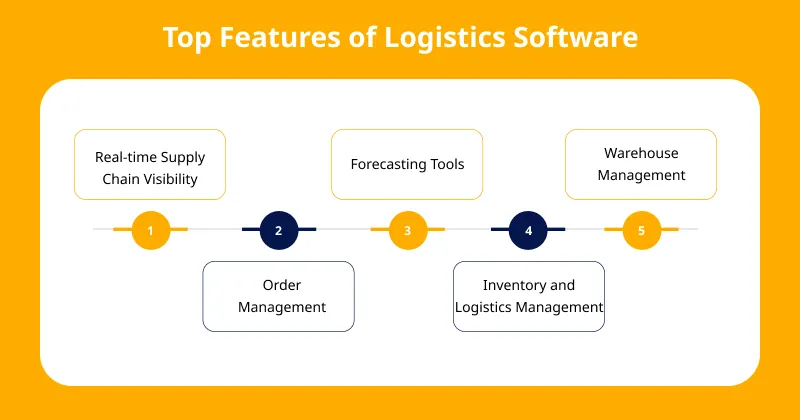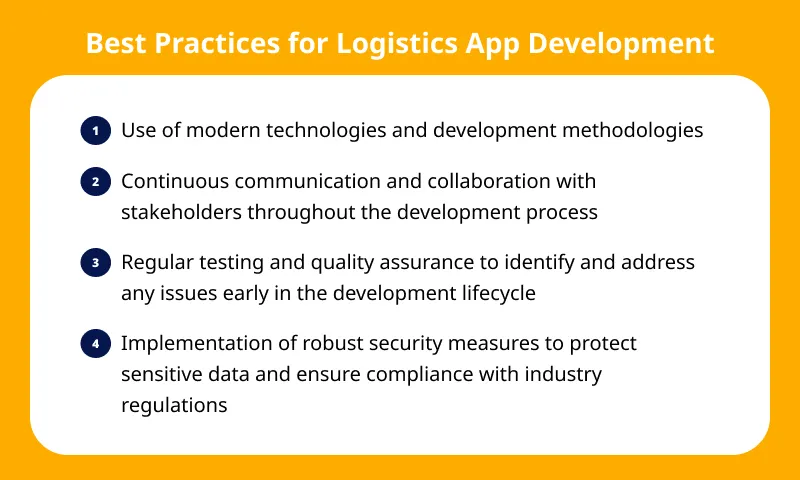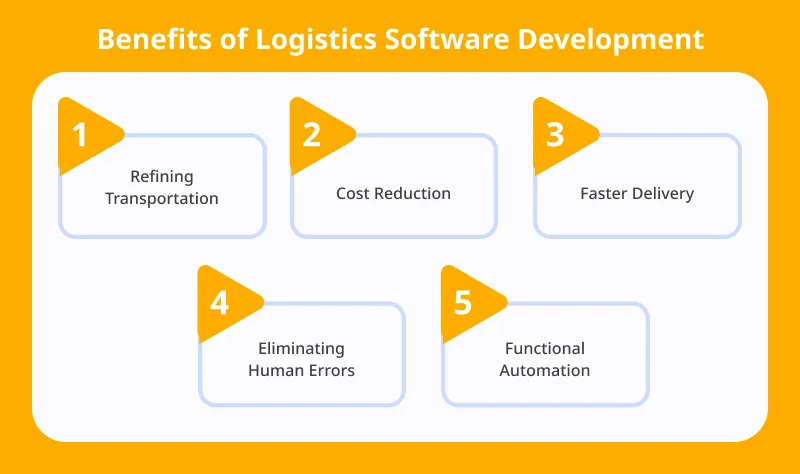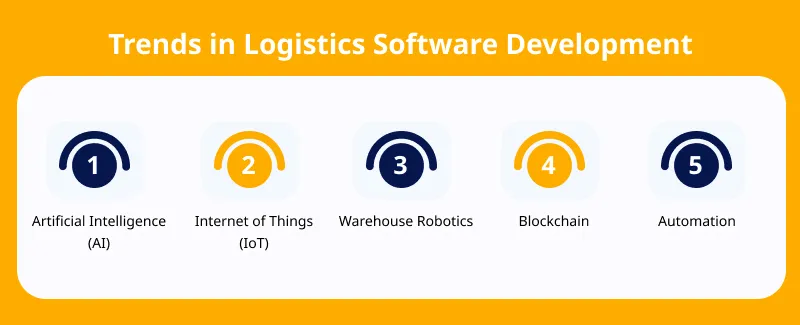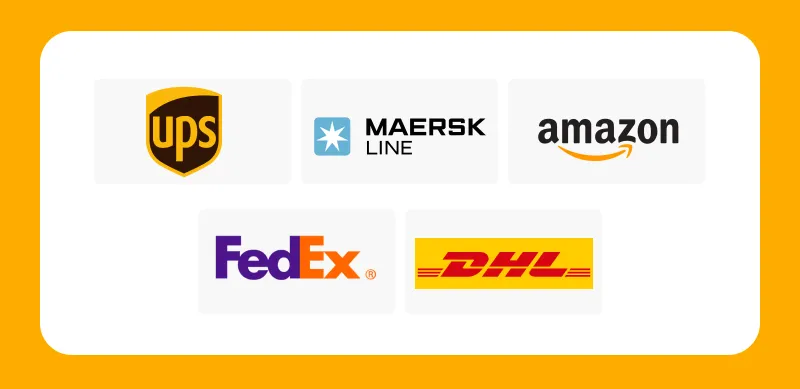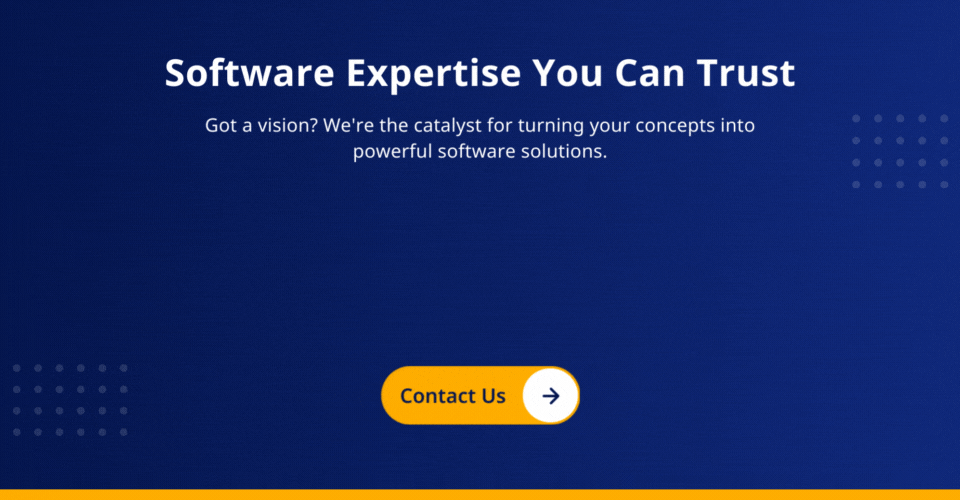Are you looking for high-quality logistics solutions that can redefine efficiency & productivity of your shipping & transportation buisness?
If yes, then you have approached the right guide.
Logistics software app development turned out as a revolution among transport businesses that aspire to optimize their business operations, enhance performance & streamline processes.
Whether it is about tracking shipments in real-time or optimizing delivery routes, the need for logistics software is utmost. However, software development has its own set of challenges that companies often face during this process.
In this logistics software development guide, we’ll discuss how you can create logistics software for a shipping and transportation company.
Let’s begin!
About Logistics Software Development
Shipping & transportation companies operate in a fast-paced environment where every minute counts. They require robust solutions & a logistics software development guide that can
- Adapt to changing demands
- Optimize resource allocation
- Mitigate risks efficiently
Logistics software development is the process of creating sophisticated digital solutions that deal with the entire supply chain ecosystem. It involves understanding the specific needs & pain points of the organization and designing software that
- Streamlines operations
- Improves efficiency
- Enhances overall productivity
At its core, it is about utilizing the power of technology to synchronize diverse processes, optimize routes, and ensure seamless collaboration across businesses.
Unlock efficiency & agility with ValueCoderscustom software solutions.
Key Considerations for Building Logistics Software
Logistics software development demands a meticulous approach. You must consider factors viz. Scalability, flexibility, and security while building logistics software. Let’s have a look at the key considerations for building flawless logistics software:
1. Comprehensive analysis
- Conduct a thorough analysis to understand the specific needs & objectives of the shipping and transportation company.
- Engage stakeholders from different departments to gather insights into their requirements & pain points.
- Align the objectives of the logistics app with the overall goals of the company to ensure strategic alignment.
2. Identify key features/functionalities
- Prioritize features such as load tracking, inventory management, route optimization, and reporting/analytics.
- Tailor the software to address the most critical needs of the company while avoiding unnecessary complexity.
- Consider functionalities that enhance visibility, efficiency, and decision-making in logistics operations.
3. Consider scalability, flexibility, and adaptability
- Design the logistics app with scalability in mind to handle increased data volumes, user traffic, and functionality.
- Ensure flexibility to accommodate changes in business processes, regulations, and market dynamics.
- Build a modular architecture that allows for easy updates & modifications to meet evolving business needs.
4. User-friendly interface & seamless integration
- Prioritize user experience design to create an intuitive & easy-to-navigate interface.
- Ensure smooth integration with existing systems such as ERP i.e. Enterprise Resource Planning and TMS i.e. Transportation Management System.
- Provide training and support to users to maximize adoption and utilization of the software.
Moreover, seamless integration with existing systems and adherence to industry standards are non-negotiable aspects of the development process.
Must Read: Glean Insights Into Software Product Development Process To Develop Successful Business Solutions
Steps to Building Logistics Software
Now, you must be ready to start the process of logistics app development. However, it requires a structured approach to ensure the success and get the desired results. Here are the key steps to follow while building logistics software development guide:
Step 1: Requirement Analysis
It enables stakeholders to gather insights into business needs & challenges.
- Conduct thorough interviews & discussions with stakeholders to understand their needs/objectives.
- Document requirements & create a detailed project scope.
Step 2: Design & Planning
This step helps in creating a blueprint for the software architecture, focusing on scalability & usability.
- Create wireframes & prototypes to visualize the user interface/user experience
- Define the architecture & technical specifications of the software
Step 3: Development & Implementation
Here comes the final stage development and implementation. It leverages cutting-edge technologies to bring the design to life and also ensures adherence to best practices.
- Write code & develop the software according to the design specifications
- Test & debug to ensure the software meets quality standards and functional requirements
Step 4: Deployment & Training
It involves rolling out the software in a phased manner. It also ensures minimal disruption to operations.
- Install & configure the software in the production environment
- Provide training & support to users to ensure a smooth transition to the new system
Top Features of Logistics Software
The power of logistics software lies in its ability to deliver a bunch of top features tailored to the unique needs of shipping & transportation businesses. Some of the top features discussed in this logistics software development guide are given below:
1. Real-time Supply Chain Visibility
- Provide real-time visibility into the entire supply chain which includes the status of shipments, delivery routes, and inventory levels.
- Enable stakeholders to track & monitor shipments at every stage of the logistics process. It ultimately improves transparency & responsiveness.
2. Order Management
- Facilitate smooth order processing from order placement to fulfillment, shipment tracking, and invoicing.
- Automate order routing, allocation, and prioritization. It further reduces manual effort & minimizes errors in order processing.
3. Forecasting Tools
- Utilize data analytics & forecasting algorithms to predict demand, supply chain disruptions, and inventory levels.
- Help shipping & transportation companies optimize inventory management, production planning and procurement based on accurate demand forecasts.
4. Inventory & Logistics Management
- Streamline inventory management processes, including picking, receiving, storageand packing.
- Optimize inventory levels to minimize stockouts and excess inventory. It improves cash flow & operational efficiency.
5. Warehouse Management
- Improve warehouse operations with features such as slotting, space optimization and labor management.
- Enable efficient order fulfillment through pick lists, automated workflows, and inventory tracking within the warehouse.
Shipping & transportation businesses optimize their operations, improve efficiency, and deliver superior customer service by incorporating these top features into logistics software.
Hence, the features discussed above help in better decision-making, enhanced visibility across the supply chain and increased productivity. It ultimately drives business growth & success.
Let's collaborate to develop innovative software solutions.
Best Practices for Logistics App Development
Building a logistics software requires a good technical expertise plus sound industry knowledge. Here we have listed some best practices as mentioned in this logistics software development guide:
1. Use modern software development methodologies
- Adopt modern technologies such as cloud computing, IoT, and AI/ML for logistics to enhance the functionality & performance of logistics software.
- Adopt agile or DevOps development methodologies to facilitate collaboration, flexibility, and rapid iteration throughout logistics & transportation software development.
2. Continuous communication & collaboration with stakeholders
- Maintain open channels of communication with stakeholders viz. shipping & transportation companies, logistics partners, end-users etc.
- Do give regular feedback and incorporate stakeholder input into the software design/ development process to ensure alignment with business objectives and user needs.
3. Regular testing & quality assurance
- Conduct thorough testing at each stage of the development process to identify & rectify any bugs, errors, or performance issues.
- Implement automated testing frameworks & tools to streamline the testing process and ensure comprehensive test coverage.
4. Implementation of robust security measures
- Incorporate access controls, encryption and data masking techniques to safeguard sensitive data, such as customer information & transactional data.
- Adhere to industry-specific regulations and compliance standards viz. GDPR (General Data Protection Regulation) & HIPAA (Health Insurance Portability and Accountability Act) to mitigate risks and ensure data privacy & security. And if you don’t yet know what is cybersecurity, your IP address, how does a virtual private network work or other data confidentiality & integrity concepts then this is a great opportunity to study this issue to be able to use more ways to securely protect your data.
Shipping and transportation businesses build efficient & reliable logistics software by adhering to these best practices. This will meet their specific needs, enhance operational efficiency, and drives business growth in the dynamic & competitive logistics industry.
Also read: 10 Ways Logistics Companies Can Benefit From AI/ML
Benefits of Logistics Software Development
The benefits of investing in logistics software are manifold. Some of its top benefits discussed in this logistics software development guide are given below:
1. Refining Transportation
- Supply chain automation solutions optimize transportation routes & modes. This leads to more efficient & cost-effective transportation.
- It also enables real-time tracking & monitoring of shipments. This will enhance visibility and control over transportation operations.
2. Cost Reduction
- Logistics software helps in lowering operational costs by streamlining logistics processes & reducing manual intervention.
- It minimizes inventory holding costs by optimizing inventory levels & reducing stockouts through better forecasting and inventory management.
3. Faster Delivery
- Logistics software facilitates faster order processing & fulfillment by automating workflows and optimizing logistics operations.
- It improves delivery speed and accuracy. This results in enhanced customer satisfaction & loyalty.
4. Eliminating Human Errors
- Automation provided by logistics & software development services reduces the likelihood of human errors in tasks such as data entry & processing.
- It enhances data accuracy and integrity. This leads to improved decision-making and operational efficiency.
5. Functional Automation
- Logistics software automates key functions such as order processing, inventory management, and shipment tracking.
- It streamlines operations, eliminates manual tasks, and improves overall efficiency through functional automation.
Shipping and transportation businesses build & deploy logistics software by leveraging these benefits. These are tailored to their specific needs. This will enhance operational efficiency, reduce costs, and deliver superior customer service.
Trends in Logistics Software Development
The landscape of logistics & transportation software development is transforming rapidly. It is driven by emerging technologies & shifting market dynamics.
Some of the key shipping logistics technology trends n logistics software development that will shape the industry include:
1. Artificial Intelligence
- AI technologies such as . Machine Learning, Predictive Analytics, etc. are transforming logistics operations.
- AI-powered algorithms optimize route planning, demand forecasting, and inventory management.
- Intelligent automation enhances process efficiency & accuracy. This improves overall logistics performance.
2. Internet of Things
- IoT revolutionizes logistics with real-time data collection & analysis capabilities.
- IoT devices like sensors, RFID tags, and GPS trackers provide visibility into shipments, vehicles, and warehouse operations.
- Logistics software leverages IoT data to monitor cargo conditions, optimize routes, and improve asset utilization.
3. Warehouse Robotics
- Robotics technologies automate repetitive tasks in warehouses. Thus, it improves productivity and reduces labor costs.
- Warehouse robots handle packing, picking, and sorting, increasing throughput and accuracy.
- Integration of robotics with logistics software streamlines warehouse operations & enhances efficiency.
4. Blockchain
- Blockchain technology ensures secure and transparent supply chain management.
- It enables traceability & provenance tracking of goods. This enhances visibility and reduces fraud.
- Logistics software utilizes blockchain to ensure data integrity. This improves trust among partners & streamlines transactions.
5. Automation
- Automation remains a key trend in logistics software development, driving efficiency and reducing manual efforts.
- Automated workflow inventory management, streamlined order processing, and shipment tracking.
- Logistics software enhances operational efficiency & enables companies to focus on strategic initiatives by automating repetitive tasks.
Shipping and transportation companies build innovative solutions by staying abreast of these trends in logistics software development. This improves efficiency, optimizes operations, and delivers superior customer experiences.
Partner with us to build cutting-edge logistics software.
A Glimpse of Some Successful Stories
Here are a few examples of successful implementations of logistics software in shipping and transportation companies. Each of these companies has leveraged technology to improve efficiency, reduce costs, and enhance customer service in their respective operations.
1) UPS (United Parcel Service)
UPS implemented its own logistics software called ORION (On-Road Integrated Optimization and Navigation) to optimize delivery routes. ORION uses algorithms to calculate the most efficient routes for drivers. It takes into account factors like
- Traffic
- Weather
- Delivery schedules
This software has helped UPS save millions of dollars in fuel costs and reduce its environmental footprint.
2) Maersk Line
Maersk (one of the world’s largest shipping companies) implemented custom shipping software solutions to streamline their supply chain operations. The software integrates various aspects of their logistics operations, including
- Vessel scheduling
- Cargo tracking
- Port operations management
This implementation has helped Maersk improve efficiency, reduce costs, and enhance customer service.
3) FedEx
FedEx utilizes a suite of logistics software solutions to manage its global transportation network. This includes software for
- Route optimization
- Package tracking
- Inventory management
- Warehouse operations
FedEx is able to provide fast and reliable delivery services while minimizing costs and maximizing efficiency by leveraging advanced technology and data analytics.
4) Amazon
Amazon has developed sophisticated logistics software to support its vast e-commerce operations. This includes software for
- Inventory management
- Order fulfillment
- Transportation optimization
- Last-mile delivery
Amazon’s logistics software enables them to offer fast and reliable shipping to customers worldwide, while also optimizing their supply chain and reducing costs.
5) DHL
DHL implemented a logistics software platform called myDHLi to digitize and streamline their shipping and transportation operations. The platform provides
- Real-time visibility into shipments
- Allow customers to track their packages from pickup to delivery
Additionally, myDHLi offers features like online booking, document management, and customs clearance assistance. Thus, it is making easier for businesses to manage their international logistics processes.
Conclusion
Finally, building supply chain management solutions for shipping & transportation businesses is a complex task.
However, your business can streamline operations, reduce costs, and improve overall efficiency by understanding the unique challenges, leveraging custom shipping software solutions and using best practices for logistics app development.
Moreover, you can hire dedicated developers from ValueCoders as they use the right approach to help businesses unlock new opportunities for growth and innovation in the ever-evolving logistics landscape.
So, whether you are just starting or looking to upgrade your existing systems, investing in logistics & transportation software development can propel your business forward & position you for success in the digital age.


